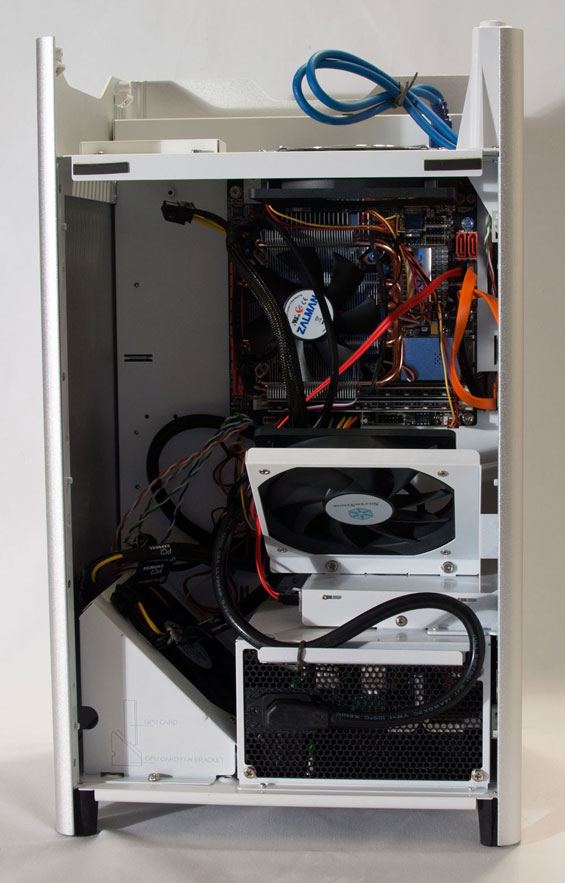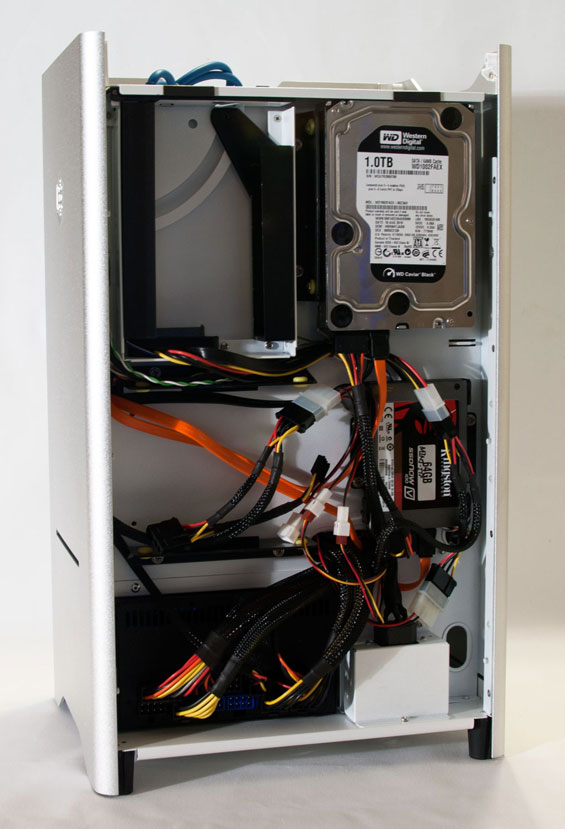SilverStone FT03: Nothing Else Like It
by Dustin Sklavos on April 28, 2011 12:25 AM EST- Posted in
- Cases/Cooling/PSUs
- SilverStone
Assembling the FT03
While most enclosures based on traditional design principles are pretty easy to figure out just by eyeballing them, SilverStone includes an instruction manual with the FT03 for a reason. Much like the GD04 we reviewed before it, there's a specific order you'll want to put the FT03 together in, but thankfully the order at least makes sense and the assembly is as painless as possible.
With this review we're experimenting a little and I've added something different. Below is a time-lapsed video of my scrawny, hairy Greek arms assembling our testbed inside the FT03 set to Chu Ishikawa's music for Tetsuo: The Bullet Man. We know video isn't for everybody (I personally like listening to music while I read reviews so something like this isn't necessarily my cup of tea), but it should be illuminating for those of you who want to get a good feel for how the FT03 gets put together.
The basic assembly of the FT03 involves removing the two intake fans and the extra fan mount at the top first, and the computer gets built essentially from the ground up. Mounting the motherboard is easy enough given the surprisingly copious space inside the case, with standoffs for at least a Mini-ITX board already built into the backplane. What's interesting is that while SilverStone recommends removing the case fans first and indeed that's what I did, it doesn't seem to be strictly necessary (at least removing the bottom one isn't). This isn't a toolless design by any stretch of the imagination, and the tiny screws used for securing the optical drive are pretty easy to lose, but it's as simple as it could be.

Installing the power supply is incredibly simple, too, although the plug used to route to the power supply (thus depriving you of access of the master switch) can have a tendency to bunch and get in the way of sliding the side panel back on.
Where I was really impressed was with the way hard drives are installed; the drive mounting standoffs actually glide into place on the case instead of making you hunt and carefully line up screws. I was admittedly a little puzzled initially with how to install the 2.5" drive tray (though that may have been 1am talking to me), but eventually it locked in exactly where it ought to go. You'll want to install the 2.5" drive with the connectors facing down towards the bottom of the case; the 3.5" drives can't be installed in any orientation other than with their connectors facing inward and down, thus helping with cable routing.

Routing cables is also handled about as well as it can be, but woe betide anyone who tries to install a non-modular power supply in this case. While it can probably be done, routing space for cables is at a premium in the FT03. There are pretty specific places the cables are supposed to route through and I found they worked as well as they could. While you can use a PSU from any vendor, if you're planning on building in this case it might be wise to cough up for a SilverStone Strider power supply specifically so you can buy short modular cables specifically designed to fit inside this case.
Honestly I'm left with few complaints in terms of the assembly of the FT03. SilverStone includes all the necessary screws along with cable ties, and their shorter modular cables fit perfectly. My only major issue is an old hand: there are three 120mm case fans included, but Micro-ATX boards with three fan headers are rarefied at best.
From there I have a series of minor gripes. First, as I mentioned before you pretty much have no choice but to use a modular power supply with the FT03, and SilverStone's shorter cables make a big, big difference. Second, you're stuck using a slot-loading slim-line optical drive. I can't complain too much; putting any other type in here would definitely ruin the aesthetic, but it does incur additional expense and I have to wonder if there wasn't another way. Maybe finding a way to mount a standard slim-line drive at the top of the case? Finally, the side panels are keyed and slot in easily enough (with some pressure, but nothing you haven't experienced assembling a hundred other cases), but they don't snap in and tend to feel a bit loose. When you move the FT03, you'll want to lift it from the front and back; the sides will slide right off.
















81 Comments
View All Comments
IlllI - Thursday, April 28, 2011 - link
why in the world would they decide to stick that ugly, plastic thing on the side?other than that it looks decent. i'd be willing to forgive the ugly plastic lid, but the thing on the side completely ruins the aesthetics
softdrinkviking - Thursday, April 28, 2011 - link
what're you talking about? the silverstone snowflake?Spoelie - Thursday, April 28, 2011 - link
no, check the gallery, third picturesoftdrinkviking - Monday, May 2, 2011 - link
oh man. i didn't see that.that is really strange; not my cup of coffee.
heffeque - Thursday, April 28, 2011 - link
He means the top grill.The tittle is "Nothing else like it", but seriously, the idea is extremely similar to this other casing:
http://www.youtube.com/watch?v=D0NbGbZBPL0&t=4...
:-)
headbox - Friday, April 29, 2011 - link
I thought I was going to get RickRolled for a second there...Yes, even the best PC cases have NOTHING on Apple designs from more than a decade ago. The PowerMac G3 and G4 cases are still miles ahead of the "high-end" from Lian Li or others. And the PowerMac G5 and Mac Pro cases are just amazing. Hate on Apple all you want, but no one designs enclosures like they do.
Oh, unless you like alien eyes on the front.
bman212121 - Monday, May 2, 2011 - link
The G3 was interesting but I don't know if I would use that setup for a full sized build. It would probably work well for this scenario though using a mini ITX. (The mainboard is mounted to the side panel and when you open up the case you lay the board down and out of the case) With a smaller size having the board basically come out of the case to mount and work on makes it so much easier to add memory, an expansion card, or work on something else in the case. The outside of the G3 is all plastic and does still look good with it.The G5 is definitely one of the nicest looking cases, but I find it hard to work inside of. (it's a fairly large case too) The thermals are covered nicely in the PowerMac but it's a real pain to insert drives. The Intel Mac Pro has a better layout but I'd still change the inside around some. If anything the solid aluminum side panel is a blessing compared to most other cases.
tbutler - Wednesday, May 4, 2011 - link
Yeah, from a easy-to-work-on standpoint, the G3/G4 design is probably the best I've ever seen. Unfortunately, towards the end of its run it started having cooling issues (remember the "Windtunnel" nickname?)The G5/MacPro case does much better on cooling; it's not as easy to work on as the G3/G4 case, but it's not bad. One thing that makes it gadget porn for me is the complete lack of cabling in the interior work area, and the near total lack of cabling at all; the only time I've ever had to mess with cabling at all was when I installed a second optical drive, and had to run a SATA cable down to the motherboard. That cable was a bit tricky to run and required disassembling more of the case than I'd like, but after that it wasn't bad. (I also had to hook up the second power lead to the optical bay, but that was pretty trivial.)
softdrinkviking - Monday, May 2, 2011 - link
no he doesn't. check the third pic, like spoelie saysRasterman - Thursday, April 28, 2011 - link
I agree, for $170 bucks, plastic is not allowed, it should be aluminum, or glass would be very cool.